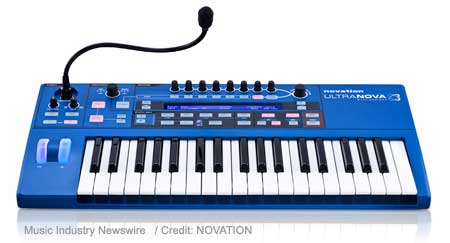Novation announce new synth keyboard, the UltraNova
EL SEGUNDO, Calif. (MuseWire) – As a long time Novation SuperNova II owner, I was pretty surprised to hear about Novation’s new keyboard, the “UltraNova,” which appears to be targeted to the popular small form factor of synths like the Akai Miniak, sibling Micron SE, Korg’s MicroKorg and R3, etc. What has been interesting to see on stage is how many vocalists have been using these small form factor (49 keys and below) synths (virtual analogs and ROMplers) to play leads without having to wear a keytar of run over behind a traditional “stack” of full-size boards.
The company describes the product as, “UltraNova is a ‘Nova’ series analogue-modelling synthesizer with a powerful effects processor. It is a single-part synth taking the legendary Supernova II synth engine as a starting point and packing it with the latest technology. It now has brand new features including wavetable synthesis, even more powerful filters, a software editor and a revolutionary new touch-sense performance mode. The ‘Nova’ family was born in 1998 with the Supernova, which was the first of a series of powerful synthesisers. These quickly became industry standard ‘big-synths’ which are still used by countless artists and sound designers.”

For me, what made the original Supernova II (circa 2000) so cool, was the “chaos” theory behind their filters for doing virtual analog. In addition to oscillators capable of reproducing classic analog sounds, the filters had a remarkable “juicy” sound to them which could sound more digital or “creamy” depending on your program needs. A kick-ass arpeggiator and ahead-of-their-time digital FX made for a very cool blue box (arguably the same color as the Tardis, for you UK fans). Since the Supernova was developed in the UK, it had a slightly different mindset than the German or US products (or Swedish, Italian, Japanese, etc.).
SRP will be $849, with street price around $699.
On to the specs, which are:
The synth engine: With 300 onboard patches you can play and perform with UltraNova straight away. But it also has a powerful synth engine derived from a classic big-synth: the Supernova II. UltraNova also has a 12 band vocoder and ships with a dynamic gooseneck microphone. UltraNova is easy to program as each part of the synth is accessed by a button which brings up all the parameters.
Polyphony
• Up to 18 note polyphonic
Timbrality
• Single Part
Oscillator Section
• 3x oscillators
• 2x ring modulators
• 1x noise generator
Choose from sine, sawtooth, square, pulse, triangle and 9x saw: pulse combinations. There are also 36 wavetables and 20 digital waveforms to chose from!
Each oscillator has:
• Density & density-detune function which can detune the oscillator against itself
• Virtual sync which allows the oscillator to sync to itself
• Hardness (which is effectively an extra low pass filter on each oscillator)
Filter Section
• 14 filter-types – you can run 2 filters simultaneously;
Filter types include high pass, band pass and low pass
Envelope Section
• 6x envelope generators
LFO Section
• 3x LFO’s
Effects
• 5x simultaneous effects per voice
Choose from: Distortion, Chorus/Phase, Delay, Reverb, Compressor, Gator, EQ; There are multiple effects routing options including series, parallel and 8 further different configurations; All effects are editable and each individual instance has its own settings.
Modulation
• 20x Modulation slots
Modulation sources:
• 6x envelopes
• 3x LFOs
• Aftertouch
• Velocity
• Key scaling/track
• Mod wheel
• Expression pedal
Can be used to modulate 66 different destinations including:
• Oscillator pitch, pulse width, wavetable index, level & sync
• Filter cutoff and resonance
• Effects parameters and send levels
• You can even modulate a modulator (envelope LFO etc…)
Vocoder Section
• 12 band vocoder, with included dynamic gooseneck microphone
Arpeggiator
• 33 Arpeggiator patterns with velocity information
• Select up, down, up&down, number of octaves, apreggiator gate-time
Chord Function
• Play in a chord, and lock it to a single note so you can play single-finger chords
VIDEO:
I hope to get a review unit and do an in-depth review here soon! -cs


